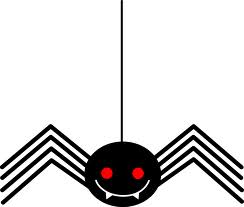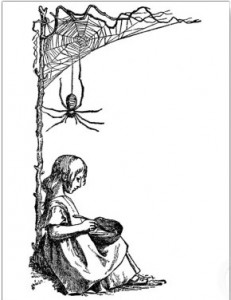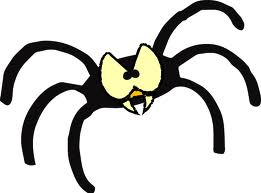Let me say this: My parents love me a lot. Anything you read hereafter, please keep that in mind. The circumstances to which they exposed me were out of a genuine intention to free me from my fear. That it did not work and that I am scarred is in no way a reflection of their greatest desire for my life to be lived in happiness and purpose.
It is not their fault their daughter was born arachnophobic.
As stated in previous posts, my parents were concerned about my overwhelming fear of spiders. They watched as I became paralyzed around the smallest of arachnids. They never acclimated to my random, high-decibel screams when a daddy long-leg tiptoed across my path. And since they could not remove spiders from this world, they sought a remedy to remove the fear from their daughter.
The most popular and effective way to eliminate a phobia is called the exposure therapy. This process involves exposing the patient to the phobic stimulus in a safe and controlled way. Depending on the phobia, exposure might be incremental. For example, someone afraid of flying might begin by picturing themselves high in the clouds, then they may watch take-offs and landings at an airport, take a tour of an airplane, and ultimately take a short flight. These baby steps give the patient a sense of accomplishment, they help build courage, and ultimately the process desensitizes them to the fear.
Sounds reasonable….. except I would actually be exposed to spiders!
Mom and Dad felt that exposure therapy was the most logical choice, and simple enough to set up themselves. All they had to do was educate me on spiders, show me how safe spiders are in their own environment, and then model their own relaxed behavior if a spider was found in our house. This was truly a labor of love on their part.
After the second grade incident with Mrs. Anderson, my parents doubled their efforts. I read dozens of books on spiders – not the Charlotte’s Web kind of books where spiders are the heroes. I read educational books, encyclopedias, and pamphlets outlining how spiders lure, catch, and then ultimately suck the life out of their prey. I learned how to identify spiders that kill humans and where they hide. My parents must not have understood that a sense of safety was the first step of exposure therapy.
My father loves weaving spiders, a.k.a. garden spiders, and believed they are some of the most amazing arthropods in the world because they spin intricate zigzags in their webs. He also believed, and still believes, that spiders provide a necessary service in this world by ridding us of bothersome insects like flies and mosquitoes and purging our gardens of destructive pests like caterpillars and beetles. He is right, of course. The creation is a magnificent web of give and take, life and death, predator and prey. It is delicate balance wherein all creatures play their part to keep our ecosystem healthy. If one aspect of this system is absent, everything is thrown out of balance and we revert to chaos.
But this in no way meant that I wanted to look at a giant spider making archetypal death designs. Spiky legs grappling across a web at breakneck speed toward an unsuspecting butterfly did nothing for my sense of well-being. I didn’t want graphic visuals of my backyard ecosystem burned into my psyche.
Dad tried to convey the beauty of his friends. He really did. Mom did, too. Alas, I remained a hyperventilating mess around spiders.
Their final attempt happened when I was thirteen years old. Eighth grade was my last year at my tiny private school. We moved to the county the year before and the county schools provided better educational resources than my private school. For the first time, after nine years of private school, I was headed to a public school. My elementary & middle school friends could not follow me into high school. I had no frame of reference for what this would even look like. I was nostalgic and excited all at the same time. And I was terribly vulnerable.
A week after my last day of eighth grade, my family took our vacation in Washington, D. C. My sister and I were finally of an age we could appreciate the sites and the museums. I already spent a day there with my eighth grade class, so this trip was a reminder of what I just left behind. My friends and I visited several of the Smithsonian’s more popular museums and my absolute favorite was the Natural History Museum. Our family vacation afforded an opportunity to explore it in greater depth.
I had a general idea of what the Natural History Museum contained. Specifically, I remembered “The Bug Room.” Unlike the other exhibits of preserved animals and fake flora, “The Bug Room” was crawling with life. Most of the insects, bugs, and arachnids in this room were alive and looking for a way out of their glass boxes. There is a family legend about my aunt, who visited this room with her school a decade previous. She and her friends were observing the aquarium filled with roaches, crawling over each other, multiplying exponentially, anxious to be free. She poked her finger onto the glass to make a point about one of the inhabitants. However, that particular roach had figured a way out and was perched outside the glass, blending in with his relatives on the other side. My aunt ended up with roach juice all over her finger.
On my second visit, I was aware of “The Bug Room,” and fully aware there existed live, large, dangerous spiders, visible and locked in semi-secure containers within the very building I was standing. I knew to stay far away. But my parents had different plans.
They discovered that “The Bug Room” offered a talk-back with one of their expert researchers. Her particular specialty: arachnids. This particular discussion: tarantulas. My parents determined this was a divinely inspired opportunity to once and for all rid me of my phobia.
At least thirty children made up a circle in “The Bug Room” with the expert seated at top of the circle, nearest the glass cases. Considering my previous circle mishap, I sat as far away from the expert as I could – directly opposite of her. I put at least ten feet between me and the lady with the little plastic box.
After welcoming us to the world of arachnids, the expert opened her little box, reached in, and pulled out a black tarantula the size of my father’s hand. I nearly lost the hot dog I just ate for lunch. But I remained seated, and by God, that was a first.
She placed the tarantula on the floor. It crawled a bit forward, feeling its way with black tufted legs. I could feel my veins contract, my blood retreating to my solar plexus. But, still, I held my ground. The hairy black thing crawling at me was at a safe distance, I told myself. I was in a room filled with parents and experienced arachnid lovers, I reasoned. I was safe, I hummed in monotone, over and over.
Before the tarantula crawled too far, the expert used her thumb and index finger to gently grab it on the either side of its body and lift it off the ground. I was fascinated – first that she would want to touch a spider, and second that she actually had touched a spider without drawing back a bloody stub. My eyes were glued. My body froze to my seat. What super powers would she display next?
She showed us the underbelly of the beast – the different segments of its body, where its eyes were. Then she shows us the fangs. I swear on my life, this thing had fangs. Across the circle, I could see them.
My respiration quickened. She explained how tarantulas don’t spin webs like spiders do. They create burrows in the ground and pounce on their prey, sinking their sharp little teeth into them to deliver a lethal dose of venom and then to suck their vital fluids dry.
I began to sweat. At thirteen, who knew spiders had visible FANGS? Thanks to this new bit of education, I would never sleep at night.
As I processed this grossly disturbing revelation, she placed the tarantula on the floor again. Tarantula’s legs were very powerful, she explained, so they could pounce their victims from a long distance. Most tarantulas, she said, are capable of leaping at least ten feet. And then pointing for emphasis, she added, “Like the distance between here and….you, little girl.”
The end of her finger pointed directly at my chest.
My eyes were fixed and dilated. All breathing ceased. I glanced at the tarantula slowly making its way across the circle toward me. I knew – just knew – any sudden movement would send that black vampire hurtling toward my face, where it would sink it’s spider fangs into my eyes and I’d be wrapped in silk forever.
I don’t remember another word from the spider lady. My body rigidly sat until the talk was through. I’m sure at some point she scooped up the tarantula and placed it in the box. I recall nothing from the finger forward. The remainder of the day is a blur – a big, black, hairy blur with fangs.
A good education is a fine thing – vital really, if we are to navigate our world with any kind of purpose or understanding. But the ultimate goal of education is not to fill our minds with formulas and events and names. Real education gives us the tools to connect the facts and figures so we have a broader understanding of our situation, our time, our circumstance. Education establishes the foundation upon which we think critically about the world and our place in it. The bits and pieces of algebra, history, grammar, and science are elemental. What we do with the elements can be profound, if we are taught how to own them.
I own my education about spiders. It has deepened my resolve that exposure is futile. I endeavor to live at all times with an eleven foot bubble between any arachnid and me. You might think that, however well-intended, I overdosed on information; which caused an illogical fear of something that is a lesser threat than I imagine. And this is where you are wrong. I was born with the illogical fear. It is elemental. My education substantiated it, underlined it, and placed an exclamation point at the end.
Eight-legged creatures with fangs have no place in my world. To hell with the ecosystem.



Geez, how awful. I too have this very “real to me” fear as the result of a spider dropping on my face while I was in bed as a little girl. My family, friends, neighbors and strangers have learned to respond to my blood curling scream and immediately link it to there is a spider nearby. One of the first things I did was teach my children how to kill spiders – not very Budha-like spirituality, but fear wins on this one. It has been a particularly bad season. I have learned to attack them because I can’t stand to let them go and know they are lurking somewhere. If no one is available or responds to my screams, I have learned to whack them until they die, shaking and crying and screaming the whole time. Yuck – Halloween, least favorite holiday ever!
So you probably don’t want to hear about the two garden spigers that lived on the corners of my deck all summer. And that roach thing is not a legend! That roach was outside the glass! And I stuck my finger on it! Ugh. Spiders ok, but roaches, well that’s another story. But I love my arachniphobic neice.!